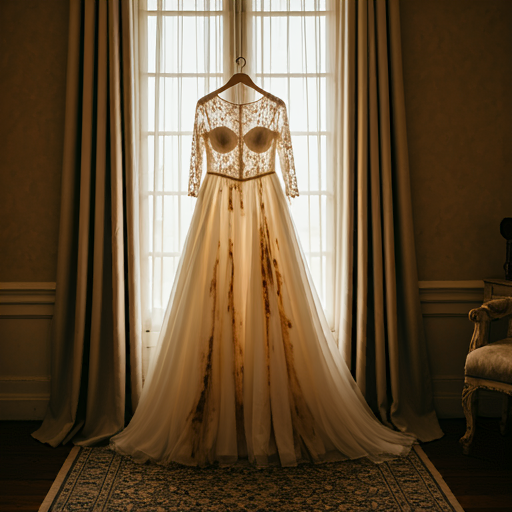This Month, 10% of every order will help support a great cause!
This Month, 10% of every order will help support a great cause!

There’s nothing quite like a wedding day. The flowers, the vows, the family and friends, and, of course, that stunning dress. But let’s face it: no matter how careful you are, a small stain might sneak onto your gown amid the celebrations. From a smudge of lipstick to a drip of wine, stains are an unwelcome guest at any wedding. The good news? Most stains can be managed with the right approach. Here’s your complete guide to removing stains from your wedding dress, so you can focus on what matters most: celebrating your love story.
Before diving into stain removal techniques, it’s helpful to understand some of the most common stains brides encounter. Each type of stain has its own personality—some are more stubborn than others, but all can be dealt with if you know what you’re up against.
Between getting ready, quick touch-ups, and all those hugs, your dress might meet a bit of foundation, blush, or lipstick. These stains can be tricky because of the oils and pigments in makeup.
Weddings are filled with delicious treats and toasts, but sometimes food and drink don't stay on the plate or in the glass. Whether it’s a sip of red wine, a drop of chocolate, or a sauce splash, food stains are common wedding dress culprits.
If you’re saying “I do” outdoors, grass stains (especially on the hem) are nearly inevitable. And even if you’re indoors, floors aren’t always spotless, so dirt and dust might find their way onto your dress.
With all the excitement and dancing, sweat and body oils can leave marks on your gown, particularly around the neckline and underarms. These stains are often subtle but can still require special care.
From last-minute hairspray spritzes to finger foods, oil-based stains can come from several sources. They’re usually less noticeable at first, but they can deepen over time if untreated.
After all the dancing and hugging, you might find small, unknown stains on your dress. It’s easy to pick up random marks without even noticing, but don’t worry—these can often be treated just as effectively as other stains.
Before jumping into stain removal, let’s cover some ground rules. Pre-treatment can set you up for success, helping to ensure that the stain removal process goes as smoothly as possible.
Time is your best friend when it comes to stain removal. The sooner you tackle a stain, the less likely it is to set. Even gently blotting it with a soft cloth can make a difference until you’re ready to treat it more thoroughly.
Avoid using bleach, harsh chemicals, or common home remedies (like lemon juice or baking soda) without testing first. Many wedding dress fabrics are delicate, and harsh substances can cause more harm than good. Always err on the side of gentleness.
Before applying any solution to your gown, test it on an inconspicuous area (like the inner hem) to ensure it won’t damage the fabric. This step is especially crucial for fabrics like silk and satin, which can be sensitive.
It’s helpful to have a few items on hand for DIY stain removal:
Let’s break down the steps to tackle each type of stain, so you’ll know exactly how to care for your dress and protect its beauty.
Makeup stains are often oil-based, which means they require extra gentleness to avoid spreading or embedding into the fabric.
Note: Avoid using alcohol-based makeup removers on delicate fabrics like silk.

Quick action can make a big difference with food and wine stains. Avoid rubbing, as it can spread the stain.
For red wine specifically, some find that diluted hydrogen peroxide can help if gently dabbed (but test first).
Grass and dirt stains usually affect the hemline or train but can happen anywhere if you’re outdoors.
Sweat stains are subtle but can sometimes be visible as a faint yellowing, especially on white gowns.
For stubborn stains, consider enzyme-based cleaners, but always test first.
Oil stains require a slightly different approach because oils need to be absorbed before being lifted.
Different fabrics respond differently to stain removal techniques, so here’s a quick guide to handle your dress based on fabric type.
Silk is delicate and can react strongly to water. For stains, try a mild detergent diluted in distilled water, but always test first. Avoid scrubbing and opt for gentle dabbing.
Lace is a bit more forgiving but has an intricate texture, so avoid rubbing to prevent snags. Use a mild detergent solution and dab carefully with a soft cloth.
Tulle is very delicate and can tear easily. For tulle stains, use a cotton swab with a diluted solution and dab lightly.
Satin can water-stain easily, so use distilled water for any treatments and always test an area first. Apply only light dabs to avoid leaving watermarks.
If the stain is deep, stubborn, or on delicate fabric, don’t hesitate to call a professional wedding dress cleaner. Professionals have access to specialized cleaning agents and know how to work with delicate fabrics.
Signs that it’s time for professional help:
Professional cleaners can also handle full dress cleaning and preservation to protect your gown for years to come.
While stains are sometimes unavoidable, you can take steps to reduce the risk.
Your wedding dress holds more than fabric—it holds memories. While stains can feel like a disaster, they’re often manageable with the right approach. Remember that patience, gentle handling, and the right techniques are your best friends when it comes to keeping your gown spotless. And when in doubt, a professional wedding dress cleaner can work wonders.
So, take a deep breath, trust in these tips, and know that, stain or no stain, your dress will always be a beautiful part of your story.